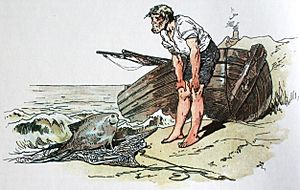The Fisherman and His Wife facts for kids
Quick facts for kids The Fisherman and His Wife |
|
|---|---|

"The Fisherman and His Wife" illustration by Alexander Zick.
|
|
| Folk tale | |
| Name | The Fisherman and His Wife |
| Data | |
| Aarne–Thompson grouping | ATU 555 |
| Country | Germany |
| Published in | Grimm's Fairy Tales |
"The Fisherman and His Wife" (in a German dialect: Von dem Fischer un syner Fru) is a classic fairy tale from Germany. It was collected by the famous Brothers Grimm in 1812. This story is about being unhappy with what you have and always wanting more. It teaches us about the dangers of being too greedy.
Contents
How the Story Began
The Brothers Grimm first shared this tale in their book Kinder- und Hausmärchen in 1812. It was the 19th story in their collection. They learned the story from a German painter named Philipp Otto Runge. He gave them a written copy of the tale in 1809. Another person, Johann Gustav Gottlieb Büsching, also published a version of Runge's story around the same time.
What Happens in the Story
The story is about a poor fisherman and his wife. They live in a tiny, simple house, called a hovel, right by the sea.
One day, the fisherman catches a very special fish. This fish says it's actually an enchanted prince! It asks the fisherman to please let it go. The kind fisherman agrees and sets the fish free.
When the fisherman tells his wife about the talking fish, she gets upset. She thinks he should have asked the fish for a wish. She tells him to go back to the sea and ask the fish for a nice, new house.
The Wishes Begin
The fisherman goes back to the shore. He feels a bit worried because the sea, which was clear before, now looks cloudy. He calls out to the fish with a special rhyme. The fish appears and grants his wife's wish for a new house.
The fisherman is happy with their new, much better home. But his wife is still not satisfied. She quickly demands more! She tells her husband to go back and ask the fish to make him a king.
The fisherman doesn't want to, but he goes back to the sea. Each time he goes, the sea gets rougher and rougher. It shows how unhappy the magical fish is becoming. The fish always grants the wishes, saying something like, "Just go home, she already has it."
More and More Wishes
Again and again, the wife sends her husband back to the fish. She keeps asking for bigger and bigger things. The fisherman knows this is wrong. He tries to tell his wife they should be happy with what they have. He warns her not to bother the fish too much. But his wife just won't listen. She is never content.
The Final Wish
Finally, the wife makes a huge demand. She wants to be able to control the sun, moon, and even the heavens! She sends her husband to the fish with the wish, "I want to be like God."
When the fisherman tells the fish this last wish, the fish simply says, "Just go home again, she is already sitting in the old hovel again." And just like that, the sea becomes calm once more. The fisherman and his wife are back in their tiny, old house, having lost everything they gained because of the wife's endless greed.
Similar Stories Around the World
"The Fisherman and His Wife" is a very old type of story. There are many other tales from different cultures that are similar. For example, there's a German story called "Hanns Dudeldee." In Russia, there's "The Old Man, His Wife, and the Fish." Japan has a story called "The Stonecutter," and India has "The Bullock's Balls." These stories all share the idea of someone wishing for more and more, often with a lesson about greed.
The Story's Impact
This famous fairy tale has inspired many other books, poems, and cartoons.
- In 1833, a Russian poet named Alexander Pushkin wrote a poem called The Tale of the Fisherman and the Fish, which was based on this story.
- The story was also used in a cartoon from The Rocky and Bullwinkle Show. In this version, a mermaid grants the wishes. The wife becomes a queen and then wants to be a "goddess." In the end, the fisherman wishes for his wife to be happy, and they return to their small house, but she is finally content.
- In 1997, the TV show Happily Ever After: Fairy Tales for Every Child made a version of the story with a Spanish twist. The fisherman wishes for his wife to be happy, and they end up back in their hovel, but she is happy and embraces him.
- An episode of the Timon and Pumbaa cartoon, called "Be More Pacific," also uses this idea. Pumbaa finds a magical whale named Lester. Timon, like the wife, keeps asking for wishes. He gets the Statue of Liberty and becomes a giant king. His last wish for a "fire-breathing monster" goes wrong, and he ends up with a fire-breathing chicken instead!

